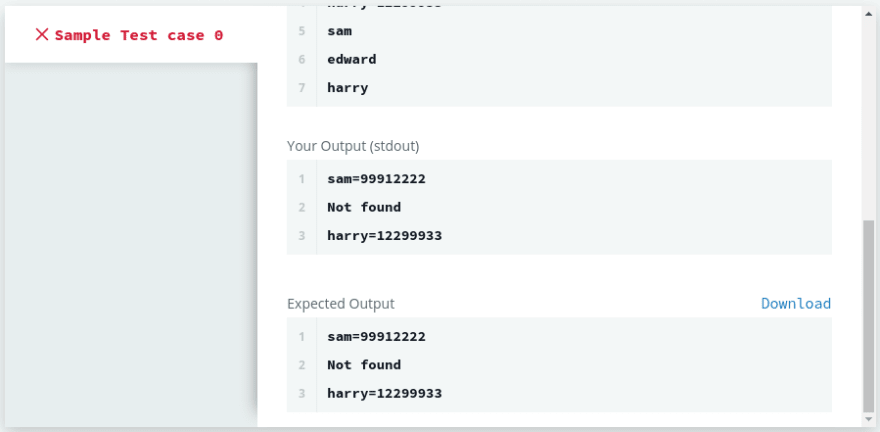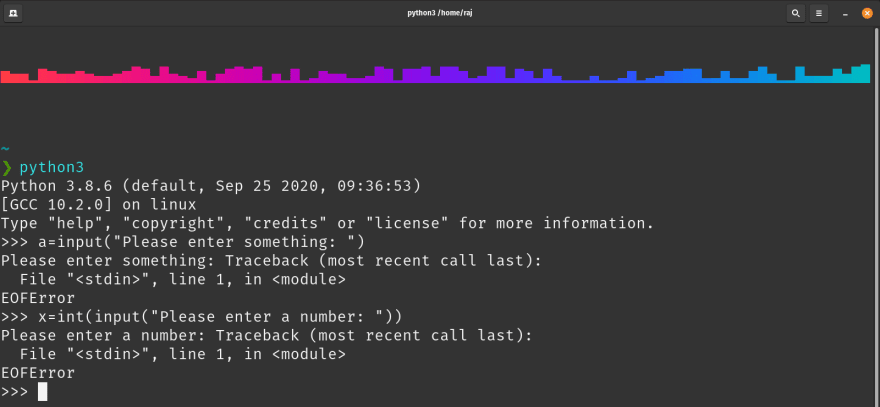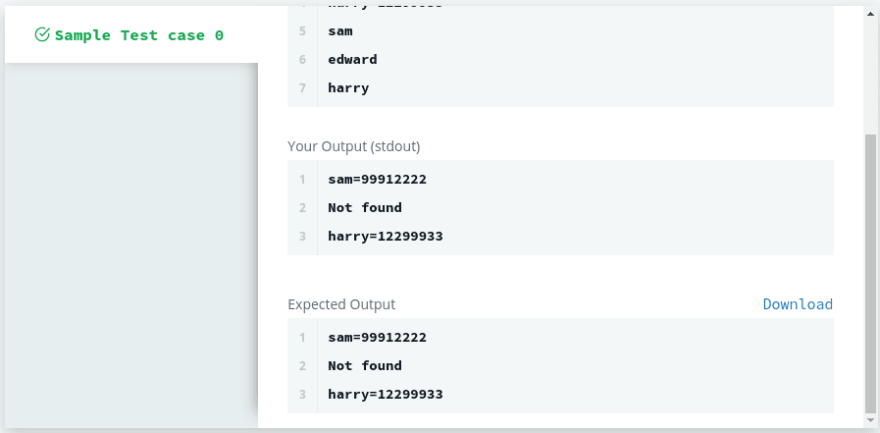
So as we can see in the pictures above, despite having produced the expected output, our test case fails due to a runtime error EOFError i.e., End of File Error. Let’s understand what is EOF and how to tackle it.
What is EOFError
In Python, an EOFError is an exception that gets raised when functions such as input() or raw_input() in case of python2 return end-of-file (EOF) without reading any input.
When can we expect EOFError
We can expect EOF in few cases which have to deal with input() / raw_input() such as:
-
Interrupt code in execution using
ctrl+dwhen an input statement is being executed as shown below
-
Another possible case to encounter EOF is, when we want to take some number of inputs from user i.e., we do not know the exact number of inputs; hence we run an infinite loop for accepting inputs as below, and get a Traceback Error at the very last iteration of our infinite loop because user does not give any input at that iteration
n=int(input())
if(n>=1 and n<=10**5):
phone_book={}
for i in range(n):
feed=input()
phone_book[feed.split()[0]]=feed.split()[1]
while True:
name=input()
if name in phone_book.keys():
print(name,end="")
print("=",end="")
print(phone_book[name])
else:
print("Not found")
Enter fullscreen mode
Exit fullscreen mode
The code above gives EOFError because the input statement inside while loop raises an exception at last iteration
Do not worry if you don’t understand the code or don’t get context of the code, its just a solution of one of the problem statements on HackerRank 30 days of code challenge which you might want to check
The important part here is, that I used an infinite while loop to accept input which gave me a runtime error.
How to tackle EOFError
We can catch EOFError as any other error, by using try-except blocks as shown below :
try:
input("Please enter something")
except:
print("EOF")
Enter fullscreen mode
Exit fullscreen mode
You might want to do something else instead of just printing «EOF» on the console such as:
n=int(input())
if(n>=1 and n<=10**5):
phone_book={}
for i in range(n):
feed=input()
phone_book[feed.split()[0]]=feed.split()[1]
while True:
try:
name=input()
except EOFError:
break
if name in phone_book.keys():
print(name,end="")
print("=",end="")
print(phone_book[name])
else:
print("Not found")
Enter fullscreen mode
Exit fullscreen mode
In the code above, python exits out of the loop if it encounters EOFError and we pass our test case, the problem due to which this discussion began…
Hope this is helpful
If you know any other cases where we can expect EOFError, you might consider commenting them below.
width, height = map(int, input().split())
def rectanglePerimeter(width, height):
return ((width + height)*2)
print(rectanglePerimeter(width, height))
Running it like this produces:
% echo "1 2" | test.py
6
I suspect IDLE is simply passing a single string to your script. The first input() is slurping the entire string. Notice what happens if you put some print statements in after the calls to input():
width = input()
print(width)
height = input()
print(height)
Running echo "1 2" | test.py produces
1 2
Traceback (most recent call last):
File "/home/unutbu/pybin/test.py", line 5, in <module>
height = input()
EOFError: EOF when reading a line
Notice the first print statement prints the entire string '1 2'. The second call to input() raises the EOFError (end-of-file error).
So a simple pipe such as the one I used only allows you to pass one string. Thus you can only call input() once. You must then process this string, split it on whitespace, and convert the string fragments to ints yourself. That is what
width, height = map(int, input().split())
does.
Note, there are other ways to pass input to your program. If you had run test.py in a terminal, then you could have typed 1 and 2 separately with no problem. Or, you could have written a program with pexpect to simulate a terminal, passing 1 and 2 programmatically. Or, you could use argparse to pass arguments on the command line, allowing you to call your program with
test.py 1 2
Introduction to Python EOFError
EOFError in python is one of the exceptions handling errors, and it is raised in scenarios such as interruption of the input() function in both python version 2.7 and python version 3.6 and other versions after version 3.6 or when the input() function reaches the unexpected end of the file in python version 2.7, that is the functions do not read any date before the end of input is encountered. And the methods such as the read() method must return a string that is empty when the end of the file is encountered, and this EOFError in python is inherited from the Exception class, which in turn is inherited from BaseException class.
Syntax:
EOFError: EOF when reading a line
Working of EOFError in Python
Below is the working of EOFError:
1. BaseException class is the base class of the Exception class which in turn inherits the EOFError class.
2. EOFError is not an error technically, but it is an exception. When the in-built functions such as the input() function or read() function return a string that is empty without reading any data, then the EOFError exception is raised.
3. This exception is raised when our program is trying to obtain something and do modifications to it, but when it fails to read any data and returns a string that is empty, the EOFError exception is raised.
Examples
Below is the example of Python EOFError:
Example #1
Python program to demonstrate EOFError with an error message in the program.
Code:
#EOFError program
#try and except blocks are used to catch the exception
try:
while True:
#input is assigned to a string variable check
check = raw_input('The input provided by the user is being read which is:')
#the data assigned to the string variable is read
print 'READ:', check
#EOFError exception is caught and the appropriate message is displayed
except EOFError as x:
print x
Output:
Explanation: In the above program, try and except blocks are used to catch the exception. A while block is used within a try block, which is evaluated to true, and as long as the condition is true, the data provided by the user is read, and it is displayed using a print statement, and if the data cannot be read with an empty string being returned, then the except block raises an exception with the message which is shown in the output.
Example #2
Python program to demonstrate EOFError with an error message in the program.
Code:
#EOFError program
#try and except blocks are used to catch the exception
try:
while True:
#input is assigned to a string variable check
check = raw_input('The input provided by the user is being read which is:')
#the data assigned to the string variable is read
print 'Hello', check
#EOFError exception is caught and the appropriate message is displayed
except EOFError as x:
print x
Output:
Explanation: In the above program, try and except blocks are used to catch the exception. A while block is used within a try block, which is evaluated to true, and as long as the condition is true, the data provided by the user is read and it is displayed using a print statement, and if the data cannot be read with an empty string being returned, then the except block raises an exception with the message which is shown in the output.
Steps to Avoid EOFError in Python
If End of file Error or EOFError happens without reading any data using the input() function, an EOFError exception will be raised. In order to avoid this exception being raised, we can try the following options which are:
Before sending the End of File exception, try to input something like CTRL + Z or CTRL + D or an empty string which the below example can demonstrate:
Code:
#try and except blocks are used to catch the exception
try:
data = raw_input ("Do you want to continue?: ")
except EOFError:
print ("Error: No input or End Of File is reached!")
data = ""
print data
Output:
Explanation: In the above program, try and except blocks are used to avoid the EOFError exception by using an empty string that will not print the End Of File error message and rather print the custom message provided by is which is shown in the program and the same is printed in the output as well. The output of the program is shown in the snapshot above.
If the EOFError exception must be processed, try and catch block can be used.
Conclusion
In this tutorial, we understand the concept of EOFError in Python through definition, the syntax of EOFError in Python, working of EOFError in Python through programming examples and their outputs, and the steps to avoid EOFError in Python.
Recommended Articles
This is a guide to Python EOFError. Here we discuss the Introduction and Working of Python EOFError along with Examples and Code Implementation. You can also go through our other suggested articles to learn more –
- Introduction to Python Range Function
- Top 7 Methods of Python Set Function
- Python Zip Function | Examples
- Guide to Examples of Python Turtle





